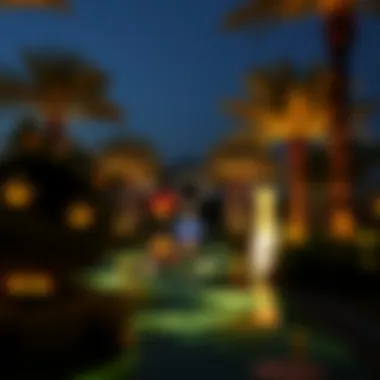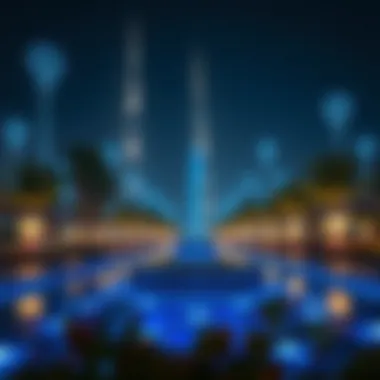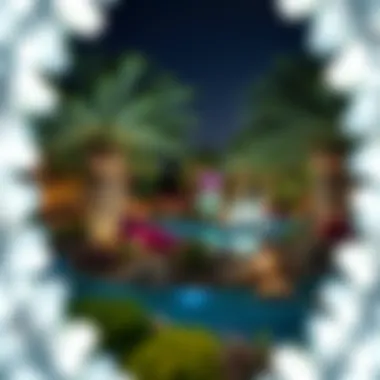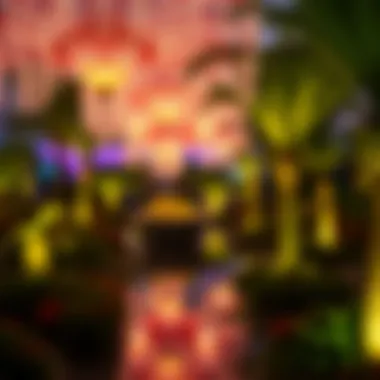Discovering Dubai's Light Garden: Art Meets Nature


Intro
Dubai has earned its stripes as a dazzling metropolis, a symbol of opulence where towering skyscrapers stretch to kiss the clouds and luxury shopping centers beckon with the latest trends. Amidst this urban grandeur lies a unique oasis—the Light Garden. This attraction doesn't merely shine; it captivates the senses, merging nature with artistic brilliance and cutting-edge technology. Here, we will journey through the essence of the Light Garden, unraveling its cultural significance, examining its design, and spotlighting its impact on community engagement.
As we traverse this illuminated sanctuary, it is essential to comprehend not only its immediate charm but also the broader implications it holds for the city’s landscape. What does the Light Garden reveal about the Emirates' ongoing evolution? How does it reflect a blend of tradition and modernity that sets Dubai apart from other global hubs? By addressing these questions, we aim to piece together a multifaceted understanding of this living artwork, illuminating its role as a beacon for residents and visitors alike.
To truly appreciate the Light Garden and its place in the city, we should first consider the market insights surrounding Dubai's real estate and urban development. Let's explore how this stunning attraction fits within the larger narrative.
Preamble to the Light Garden
As urbanization rises, cities are continuously on the lookout for innovative ways to enhance their landscapes and create spaces that offer not just utility, but also aesthetic and cultural value. The introduction of parks and intelligent designs is key in modern urban planning. In this spirit, the Light Garden in Dubai stands as a paramount example of blending art, technology, and nature within an urban context. This section explores its significance by diving into the core concepts and historical backgrounds that shaped its creation.
Defining the Concept
At its heart, the Light Garden is a multi-sensory environment that aims to immerse visitors in a world where illumination and greenery coalesce. It transcends the traditional notion of what a garden represents, introducing an innovative fusion of art installations, interactive lighting displays, and natural landscapes. The biggest draw, perhaps, is how it invites people to engage with both the physical space and the ephemeral art that illuminates it. In simpler terms, it’s not just a space to stroll and admire flora; it’s a vibrant playground for the senses, offering surprises at every turn.
Such concepts are essential for modern investors and developers, as they underline the trend towards experiential spaces. They emphasize the need to create environments that cater to a more engaged audience—one that seeks not just to visit, but to experience and connect.
Historical Background
The Light Garden is not an isolated phenomenon but a result of evolutionary thought on urban design. In the context of Dubai, it emerges from a desert that transforms into a city of dreams. Over the years, the city has cultivated an image as a leading global destination, drawing influences from various cultures, including Islamic architecture and modern design philosophies.
Historically, parks in urban areas thrived around the need to provide vital green spaces amid concrete jungles. However, as Dubai sought to elevate its global stature, the desire for unique and dynamic attractions grew. This ambition gave birth to the Light Garden—a testament to Dubai’s desire to push boundaries. Demartini's principles of biodegradable design and viewing nature through different lenses influenced its concept. As urban development surged, the Light Garden emerged from aspirations to create ecological consciousness alongside visual splendor.
"The Light Garden serves as a beacon of innovation in a city defined by its transformative ethos."
For further insights, you can explore resources like Wikipedia and Britannica, which provide enriching contexts to urban landscapes.
Design Principles and Aesthetic Features
Understanding the design principles and aesthetic features of the Light Garden is crucial for grasping its overall allure and significance in Dubai's urban tapestry. This section delves into how architecture, lighting technologies, and natural elements blend seamlessly to create a mesmerizing experience that captivates visitors and enhances community ties.
Architectural Elements
Architectural features of the Light Garden are more than just eye-catching; they play a vital role in establishing an atmosphere that feels both serene and vibrant. The architects employed organic shapes and flowing lines to evoke the natural beauty of the surrounding landscape. This is not merely about form over function; the layout encourages movement and exploration. Pathways wind through the garden, encouraging visitors to take a leisurely stroll and discover various installations.
The use of local materials, which signify a connection to the Emirati culture, further supports the architectural vision. Structures often incorporate traditional designs alongside modern aesthetics, creating a unique blend that speaks to the heritage of the region while embracing technological advancements.
Modern additions, such as open-air amphitheaters, allow for community events, connecting the built environment with social engagement. This unites the physical presence of the Garden with the community, offering a space for festivals or performances that resonate with both residents and tourists alike.
Lighting Technology
Lighting technology serves as the heartbeat of the Light Garden, transforming the space from a mundane park to a canvas of color and creativity. Here, light not only illuminates but also narrates stories. Employing smart lighting systems, the garden utilizes LED fixtures that adapt to both the time of day and the season, ensuring an ever-evolving atmosphere.
The interplay of light and shadows is masterfully executed, adding depth and interest to the landscape. Art installations are enhanced by targeted lighting, creating a vibrant contrast that draws attention to specific features while maintaining an overall harmony. Moreover, these energy-efficient lighting solutions reflect a commitment to sustainability, blending artistry with environmental responsibility.


Natural Integration
Integrating natural elements into the Light Garden underscores a commitment to preserving the ecological balance while enhancing aesthetic appeal. Careful planning ensures existing flora is maintained while new plantings contribute to biodiversity. This not only beautifies the space but also provides habitats for local wildlife.
Water features, weaving through gardens, serve multiple purposes: aesthetic pleasure, air cooling, and supporting local fauna. Trees are strategically planted to provide shaded areas, creating cozy spots for relaxation. Additionally, the careful selection of native plant species ensures they thrive without heavy reliance on irrigation, aligning the garden’s operation with sustainable practices.
Cultural Significance
The cultural significance of the Light Garden transcends mere aesthetics and technological innovation. This lush haven is more than a visual delight; it encapsulates the very essence of Dubai's evolving identity. By harmonizing art, nature, and community, the Light Garden serves as a focal point for cultural dialogue and expression.
Artistic Expression
Throughout history, gardens have acted as canvases for artistic expression. The Light Garden is no exception. Local and international artists have contributed their creative energies to this project, transforming plants, lights, and spaces into vivid narratives. Each installation tells a story, with themes often reflecting local traditions or contemporary issues. This not only fosters appreciation for diverse art forms but also encourages emerging artists to showcase their work in an inspiring milieu.
Visitors can marvel at works that blend graffiti art with illuminated sculptures, creating a surreal visual narrative that entices onlookers. The garden exemplifies how art can flourish in unexpected spaces, altering perceptions of both nature and urbanity.
Artists are often inspired by the surrounding flora, using organic shapes and forms to intertwine their art with the natural environment. The assembled pieces do not merely exist within the garden; they interact with their surroundings. For example, light installations that change throughout the night resonate with the stars above, generating a beautifully cohesive experience.
Symbolism in Design
Every nook and cranny in the Light Garden is laden with symbolism. Designers intentionally chose materials and colors that echo local heritage, melding traditional Arabic motifs with contemporary design sensibilities. The geometric patterns found in the walkways mirror those seen in Islamic architecture, grounding the garden in its rich cultural roots.
Moreover, the use of light itself symbolizes hope and enlightenment. It signifies the aspirational spirit of Dubai, embracing innovation while honoring its past. For many visitors, walking through the illuminated paths evokes a sense of serenity, reminding them of the intricate connections between the environment, humanity, and technology.
"In the Light Garden, each flicker of light serves as a reminder of the stories we share and the futures we aspire to create."
This symbolism makes the garden not just a space for relaxation but a poignant reminder of cultural narratives, resilience, and community. It invites individuals to reflect on their own identities amidst a backdrop of shared experiences.
In essence, the Light Garden stands as a testament to Dubai's diversity and commitment to cultural expression. By marrying artistic endeavors with symbolic design, it not only enhances the visitor experience but also nurtures a deeper appreciation for the cultural fabric of the city.
Community Involvement and Events
Dubai's Light Garden serves as more than just a visual feast; it stands as a dynamic hub fostering community ties and enriching the local culture through various events and initiatives. Engaging local residents plays a pivotal role in making the Light Garden not just a tourist attraction but a cherished part of their daily lives.
Engaging Local Residents
Engagement of local residents within the Light Garden's initiatives creates a ripple effect that benefits the whole community. Local residents take ownership of the space, making it their own. Activities like community clean-up days, gardening efforts, and neighborhood gatherings deepen connections among residents. They come together to celebrate cultural festivals, share culinary experiences, and participate in art exhibitions. An inviting atmosphere is nurtured through these interactions, enabling residents to feel at home.
Traditionally, community engagement tactics often think only about surface-level involvement. However, feedback channels such as surveys or focus groups invite residents to share their thoughts, ensuring their voices are heard. Such practices are instrumental in tailoring events to reflect the community's character.
- Local art exhibits showcasing talent from the neighborhood
- Seasonal celebrations that draw crowds from nearby areas
- Workshops that promote skill-sharing and learning
Each of these elements encapsulates how the garden blossoms not just in aesthetics but in community spirit.
Workshops and Activities


Workshops and activities at the Light Garden are designed with inclusivity in mind. They cater to a wide range of interests and age groups, offering something for everyone. From potting plants to creating light sculptures, participants tap into their creativity and explore new hobbies. Furthermore, professional artists and local experts often lead these workshops, guiding participants through hands-on experiences while sharing unique insights about various techniques.
Activities like guided night walks illuminate the flora while educating visitors on the ecology within the garden. These experiences foster a respect for nature while providing families with an enjoyable outing.
Some of the popular workshops include:
- Photography Classes: Capture the stunning light installations after dusk.
- Nature Crafts: Use local materials to create sustainable art.
- Culinary Events: Cook delicious dishes using herbs grown on-site.
Overall, the workshops align closely with Dubai's vision to enhance community well-being, encouraging lifelong learning and interaction in a communal setting.
Community spirit thrives when residents contribute their talents and collaborate on projects.
Through community participation and engaged events, the Light Garden becomes a vibrant tapestry interwoven with local culture, skill, and identity. This phenomenal initiative not only enhances Dubai's charm but serves as a model for urban spaces around the globe.
Environmental Considerations
The relationship between urban development and environmental sustainability is increasingly significant in today's fast-paced world. In the context of the Light Garden, these considerations take a front seat as the project contemplates the environmental implications it has not only for Dubai's skyline but also for the surrounding flora and fauna. The integration of sustainable practices is not merely a trend; it embodies the belief that urban spaces should nurture and respect natural ecosystems rather than commandeering them. This section delves into two crucial dimensions: sustainability practices being employed, and how they contribute to maintaining vibrant green spaces and biodiversity.
Sustainability Practices
Sustainability sits at the heart of the Light Garden's philosophy. Fundamental to its design is the conscious effort to use resources wisely, which resonates with the UAE's push toward a greener future. Here are some of the notable practices undertaken within the garden's development:
- Renewable Energy: The Light Garden incorporates solar panels that harness the abundant sunlight typical of Dubai, allowing the garden to operate using clean energy.
- Water Conservation: Advanced irrigation techniques are deployed to minimize water use while ensuring the health of the plants. The systems recycle greywater, thereby reducing wastage.
- Eco-friendly Materials: Construction within the garden employs materials that are sustainably sourced, significantly lowering the carbon footprint associated with building practices.
- Waste Management: Emphasis on recycling and composting reduces landfill contributions, fostering a culture of waste minimalization within both the garden and the larger community.
By undertaking these initiatives, the Light Garden serves not only as a beautiful space but as an educational platform highlighting the importance of environmental stewardship.
Green Spaces and Biodiversity
Preserving and enhancing green spaces is critical, especially in arid regions like Dubai. The establishment of the Light Garden stands as a testament to how urban areas can successfully contribute to biodiversity. Here’s how this initiative is making strides:
- Native Plant Species: The selection of flora within the garden prioritizes native species that thrive in the local environment. This helps in conserving local biodiversity and provides a habitat for native wildlife.
- Wildlife Corridors: The garden is designed with paths and habitats that encourage local species to move freely and safely, promoting a biodiverse ecosystem. This enhances the resilience of the area’s wildlife.
- Educational Outreach: Various programs run at the Light Garden focus on educating visitors and community members about local ecosystems and biodiversity. Engaging workshops clarify the interdependence between plants and wildlife, driving home the significance of maintaining a balanced ecosystem.
"A well-tended garden is like a public library with no books; it nourishes the soul without overwhelming it with noise."
Visitor Experience
The Light Garden stands as not just a visual spectacle but an immersive experience that leaves an indelible mark on its visitors. The multisensory adventure invites curiosity and invites guests to explore the interplay between light, sound, and nature. Understanding the visitor experience is crucial as it informs not only how people engage with the attraction, but also its broader implications for urban development in Dubai.
The significance of this experience is rooted in several factors:
- Engagement: When visitors step into the Light Garden, they embark on a journey that engages all senses, from the luminous pathways underfoot to the natural scents lingering in the air.
- Inclusivity: The design provides accessibility for all, inviting families, tourists, and locals to take part in a shared space that reflects cultural diversity and community spirit.
- Memories: Each corner and every light installation has a story to tell, allowing visitors to create lasting memories and personal connections with the environment around them.
Navigating the Garden
To fully appreciate what the Light Garden offers, understanding how to navigate this enchanting space is essential. The layout encourages exploration, with winding paths that guide visitors through distinct zones, each uniquely illuminated for a memorable experience.


- Signage is intuitively placed, directing visitors without obstructing the natural flow of the garden. Each sign features visually appealing designs that resonate with the overall aesthetic of the park, ensuring visitors can seamlessly immerse themselves in the art and technology.
- Guided Tours: Options for guided tours provide insights into the artistic inspirations behind each installation, making the visit more enlightening. Knowledgeable guides share stories and details that enrich the visitor experience beyond the visuals.
- Self-Guided Exploration: Those who prefer their own pace can embark on a personal journey with self-guided maps available at the entrance. These maps highlight key points of interest and provide context, enhancing individual exploration.
Seasonal Exhibits
The Light Garden is ever-evolving, hosting seasonal exhibits that reflect the changing environment and cultural festivities. These exhibits are designed to captivate and surprise returning visitors, allowing for a fresh experience with each visit.
- Thematic Installations: Each season introduces new artistic elements, from summer tropical vibes to winter wonderlands, adapting the light's hues and forms. For instance, Autumn may feature installations that emulate falling leaves, whereas Spring could celebrate blooming flowers utilizing vibrant colors.
- Cultural Events: Seasonal lights often align with local festivals, allowing for a melding of cultural festivities with art. Such exhibits create a tapestry of experiences and foster an appreciation for the blending of community and creativity.
- Interactive Features: During certain seasons, installations may encourage visitor interaction. For example, visitors might touch certain elements to activate light patterns or sounds, transforming passive observers into active participants.
Future Development Prospects
The exploration of future development prospects surrounding the Light Garden offers integral insights into how this attraction can further evolve while enhancing Dubai's urban fabric. Understanding these prospects not only benefits local stakeholders, including investors and real estate developers, but it also contributes to creating a sustainable and vibrant community space that resonates with visitors. By examining expansion opportunities and lessons learned from the Light Garden, we can begin to uncover potential pathways for future enhancements and their implications for the city.
Expansion Opportunities
The expansion of the Light Garden presents a range of possibilities that could amplify its allure. Some of these opportunities include:
- Additional Thematic Zones: Introducing new themed areas that explore different cultural motifs or natural landscapes can captivate a broader audience. For instance, incorporating zones inspired by regional flora and fauna can create educational spaces that reflect the UAE's own biodiversity.
- Collaborative Installations: Partnering with local artists and international light designers can lead to fresh perspectives in art installation. This not only invigorates the garden’s aesthetic but also promotes cross-cultural artistic exchange.
- Technological Innovation: As technology evolves, integrating new lighting systems and soundscapes can enhance the immersive qualities of the garden. Use of interactive exhibits that respond to visitor movement or sound could draw visitors in and increase engagement.
- Community Amenities: Adding facilities such as cafes, gift shops, or event spaces would boost visitor appeal. These amenities can also provide local entrepreneurs opportunities to thrive, fostering a sense of community ownership.
Each expansion opportunity not only serves to attract more visitors but also ensures that the garden remains a dynamic environment. This adaptability is key to keeping the Light Garden relevant amidst the rapidly-changing tastes of a global audience.
Lessons from the Light Garden
The Light Garden has progressively carved out its niche as a significant cultural and social epicenter in Dubai. The lessons drawn from its development can inform future urban projects in the region:
- Community Engagement is Essential: Successful public spaces thrive on the involvement and feedback of local residents. Conducting workshops, engaging surveys, or hosting advisory meetings can create a sense of shared ownership, making community members feel invested in the garden’s success.
- Flexibility in Design: The ability to adapt to feedback and changing needs is vital. An iterative design approach, where elements are continuously refined based on visitor experiences, can greatly enhance the relevancy of any attraction.
- Balance between Nature and Technology: The integration of natural elements with cutting-edge technology can create a harmonious atmosphere. Ensuring that innovations do not overshadow the garden’s greenery is crucial, as this relationship is what differentiates this space from other urban structures.
- Environmental Sustainability: Observing how natural ecosystems can coexist with artificial lighting underscores the importance of sustainability. Learning from the garden’s impact on local wildlife and plant life can help in planning future developments that do not just respect but enhance the natural world around them.
In the world of urban design, a vision for the future is only as good as the lessons learned from the past.
Ending
The exploration of the Light Garden shines a light on its vital role within Dubai’s urban fabric. By integrating artistry, environmental sustainability, and community engagement, this unique oasis offers various benefits that go beyond mere aesthetics.
The Light Garden's Legacy
The legacy of the Light Garden is built upon its transformative impact, not only as a space of visual delight but also as a catalyst for change. This garden stands as a testament to the potential of public spaces that blend nature and technology. A few significant aspects of its legacy include:
- Cultural Enrichment: The Light Garden fosters a stronger sense of identity among residents, linking them to a rich tapestry of art and innovation.
- Environmental Awareness: Promoting eco-friendly practices, the garden educates visitors about sustainability and biodiversity, raising awareness about the need for conservation.
- Community Bonds: By hosting communal events and programs, the garden encourages social interactions, further solidifying its importance as a local gathering spot.
The Light Garden's legacy can also serve as a blueprint for future projects, emphasizing the importance of integrating ecological thinking into urban planning.
A Model for Urban Innovation
The Light Garden represents an innovative approach to urban design, showcasing how cities can evolve by harnessing art and technology. Its model embodies a few core principles that can inspire future developments:
- Interactivity: The use of responsive lighting systems invites visitors to engage directly with their environment, transforming their experience.
- Sustainability: By utilizing renewable energy sources and eco-friendly materials, the garden sets a standard for future urban green spaces.
- Inclusivity: Designed to accommodate people of all ages and backgrounds, the Light Garden promotes a sense of belonging and community involvement.
As urban areas continue to expand, the Light Garden stands as a beacon of innovation, proving that cities can be spaces of beauty, creativity, and connection. This pioneering project not only enriches Dubai’s landscape but also offers insights and inspirations for cities worldwide, adapting to changing demographics and ecological challenges.
"In designing the future of cities, we can take cues from the Light Garden, where beauty meets practicality in a dance of light and nature."
For further reading on urban innovation and sustainability, consider looking into resources like The World Economic Forum, Britannica, or community-focused urban development on Reddit.
This conclusion encapsulates the multifaceted significance of the Light Garden, ensuring readers recognize its importance as not just a visual spectacle, but a progressive model for future urban developments.













